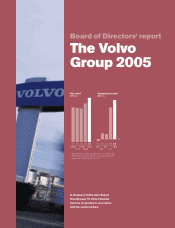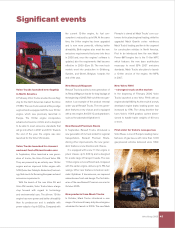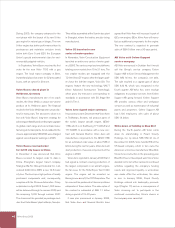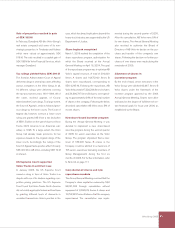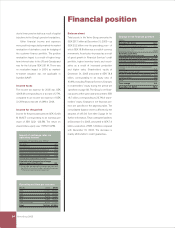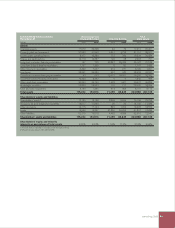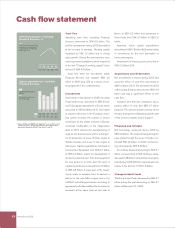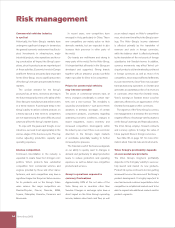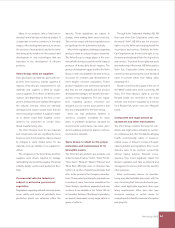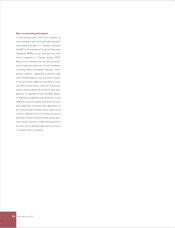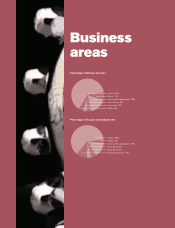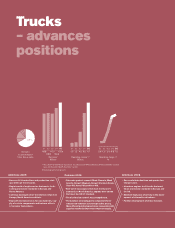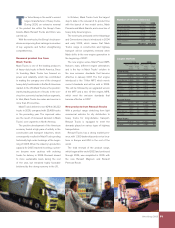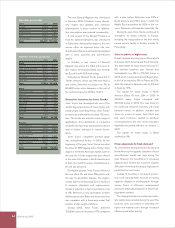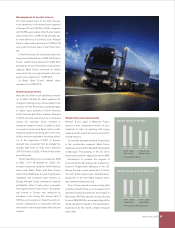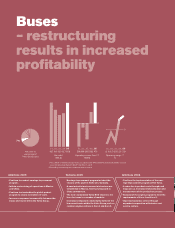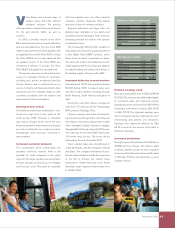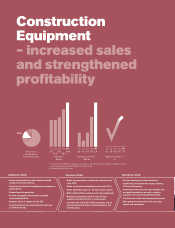Volvo 2005 Annual Report Download - page 58
Download and view the complete annual report
Please find page 58 of the 2005 Volvo annual report below. You can navigate through the pages in the report by either clicking on the pages listed below, or by using the keyword search tool below to find specific information within the annual report.
54 Volvo Group 2005
Risk management
Commercial vehicles industry
is cyclical
Historically, the Volvo Group’s markets have
undergone significant changes in demand as
the general economic environment has fluctu-
ated. Investments in infrastructure, major
industrial projects, mine operations and hous-
ing construction all impact the Group’s oper-
ations, since its products are an important par t
of these activities. Economic trends in Europe
and North America are particularly important
for the Volvo Group, since a significant portion
of the Group’s net sales are generated in these
markets.
The cyclical demand for the Group’s
products has, at times, restricted, and may in
the future temporarily restrict, the ability of the
Volvo Group to manufacture and deliver orders
in a timely manner. A prolonged delay in the
Group’s ability to deliver ordered products on
a timely basis at a time when its competitors
are not experiencing the same difficulty could
adversely affect the Group’s market shares.
To cope with the peaks and troughs in our
industries, we need to act appropriately in the
various stages of the business cycle. This may
involve adjusting production capacity and
operating expenses.
Intense competition
Continued consolidation in the industry is
expected to create fewer but stronger com-
petitors. Volvo’s products face substantial
competition from commercial vehicles and
engines provided by these and other manu-
facturers, and such competition may have a
significant impact on the prices Volvo receives
for its products and on the Group’s future
sales volume. Our major competitors are
DaimlerChrysler, Paccar, Navistar, MAN,
Scania, Caterpillar, Komatsu, Cummins and
Brunswick.
In recent years, new competitors have
emerged in Asia, particularly in China. These
new competitors are mainly active on their
domestic markets, but are expected to also
increase their presence in other parts of
the world.
Our brands are well-known and strong in
many parts of the world. For the Volvo Group,
it is important that all brands in the Group are
developed and supported. Strong brands
together with an attractive product portfolio
make it possible for Volvo to be competitive.
Prices for commercial vehicles
may become unstable
The prices of commercial vehicles have, at
times, changed considerably in certain mar-
kets over a short period. This instability is
caused by several factors – such as short-term
variations in demand, shortages of certain
component products, uncertainty regarding
underlying economic conditions, changes in
import regulations, excess inventory and
increased competition. Overcapacity within
the industry can occur if there is an economic
downturn in the Group’s major markets
or worldwide, potentially leading to further
increased price pressure.
The financial result of the business depends
on our ability to quickly react to changes in
demand and particularly to adapt production
levels, to reduce production and operating
expenses, as well as deliver new competitive
products and services.
Group’s operations exposed to
currency fluctuations
Approximately 90% of the net sales of the
Volvo Group are in countries other than
Sweden. Changes in exchange rates have a
direct impact on the Volvo Group’s operating
income, balance sheet and cash flow, as well
as an indirect impact on Volvo’s competitive-
ness, which over time affects the Group’s earn-
ings. The Volvo Group’s income statement
is affected primarily by the translation of
rev enues and costs in foreign currencies,
while the balance sheet is affected primarily
by the translation of the net assets of foreign
subsidiaries into Swedish kronor. In addition,
currency movements may affect Volvo’s pri-
cing of products sold and materials purchased
in foreign currencies as well as those of its
competitors, which may be affected differently
by such movements. Since Volvo has substan-
tial manufacturing operations in Sweden and
generates a substantial portion of its revenues
in currencies other than the Swedish krona,
Volvo’s earnings in Swedish kronor could be
adversely affected by an appreciation of the
Swedish krona against other currencies.
The objective of the Volvo Group’s currency
risk management is to minimize the short-term
negative effec ts of exchange-rate fluctuations
on the Group’s earnings and financial position.
The Volvo Group employs forward contracts
and currency options to hedge the value of
future payment flows in foreign currencies.
See Note 36 on page 121 for more infor-
mation about financial risks and instruments.
Volvo Group’s profitability depends
on successful new products
The Volvo Group’s long-term profitability
depends on the Company’s ability to success-
fully launch and market its new products.
Product life cycles continue to shorten, putting
increased focus on the success of the Group’s
product development. It is highly important to
meet and exceed customer expectations to be
competitive in established markets and to be
able to expand into additional markets and/or
product segments.


